Sandy Wright's Blog, page 11
September 8, 2018
Book recommendation: Poison Girls
 At the beginning of the summer, I agreed to write a column for our community newspaper, The Pinewood News. Every other week I submit columns and book reviews for the residents in Munds Park, our little cabin community.
At the beginning of the summer, I agreed to write a column for our community newspaper, The Pinewood News. Every other week I submit columns and book reviews for the residents in Munds Park, our little cabin community.This obligation has gotten me reading a lot more this summer. I’d been avoiding reading for the last year because I thought it would take away from my novel writing time. Actually, the opposite has been true. I read mostly during lunch and before going to bed at night.
Instead of being a “time suck,” reading seems to rev up my imagination and get me thinking constantly about word choice and phrasing, not to mention how much new information there is to learn from other author’s books.
I also joined Netgalley, an online service that connects publishers and authors to a community of early influencers who will help their book succeed: librarians and booksellers, who order an recommend books to their patrons; media professionals who interview authors and publish book reviews; and reviewers and bloggers like me who write about books online and leave reviews on retail sites and more. I have already requested a dozen newly-published or not-yet-published books that I’m excited to read. On this blog, I’ll give you the “best of the best” as I come across them, starting with Poison Girls, by Cheryl Reed.
I actually discovered Cheryl’s book during a workshop at Left Coast Crime. She was on a panel of authors who have moved from newspaper crime reporting to writing novels. I thought the panel was interesting because, as a past journalist myself, I rarely feel that novelist get the atmosphere of a newsroom exactly right, and even fewer accurately describe the pressures on a crime reporter.
But Poison Girls nails it all—the political maneuvering of publishers and editors, the back-stabbing competition between co-workers, and especially the daily ethical decisions the reporters are forced to make, with no safety net from prosecution.
The novel ls is set in South Side Chicago in 2008 where teenage girls of prominent and wealthy families are dying from fentanyl-laced heroin called “poison.”
Natalie Delaney, a crime reporter for the struggling Chicago Times, is determined to get to the bottom of the deaths. She navigates the world where thrill-seeking teens and hardened drug dealers coexist, by developing a friendship with Libby and Anna, two cousins who are dabbling in the drug world.
Natalie senses that these are not ordinary OD’s, but her new friend, Anna, leads her in confusing circles around the truth. Eventually she traces some unlikely links between the South Side drug dealers and the city’s power brokers, but she still doesn’t know why these young, affluent girls are willing to try a drug that will likely kill them.
As the death toll rises, Natalie finds herself chasing one of the biggest stories of her career. We get a sharp sense of the false leads, half-truths and frustrations that are part of reporting a story that no one else seems eager to break open. The paper is happy to run her page one articles when the focus is on the tawdry deaths and gang involvement. But when the reporting leads to politicians and some of Chicago’s most well-connected families, Delaney is hung out to dry.
Although the drug culture is realistically portrayed, it is the reporter’s life that rings true throughout. Delaney is a flawed and sometimes unsympathetic character, struggling with the ethical dilemma she is thrown into. How does she separate getting the story and becoming personally involved with the people in it? Is it ethical to observe a crime being committed, and not stop it, for the sake of the article? The exploration of her inner life adds layers of depth to the story, and several times I stopped and asked myself what I would do if faced with the same situation.
Cheryl Reed’s Poison Girls is a gripping tale that often reads like creative nonfiction. And for good reason. Reed, a long-time crime reporter, drew the story from her own experiences covering a group of young girls using crack cocaine in Dayton in the 1990s. A former editor and reporter at the Chicago Sun-Times, Cheryl has won many awards for her investigative reporting.
This is Reed’s first fiction novel. Her non-fiction book. Unveiled: the Hidden Lives of Nuns, chronicles her four years living off and on with nuns across the country.
At the time of this writing, Poison Girls has 29 Amazon reviews, all of them 5-Star.
Paperback: 374 pages. Also available in ebook format.Publisher: Diversion Books (September 12, 2017)
Published on September 08, 2018 16:00
August 31, 2018
Finding a Tree Ally
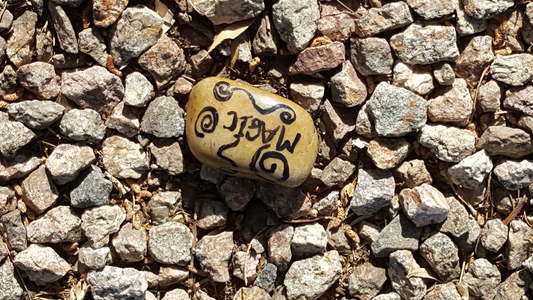 Imagine walking into a forest where you are greeted by many old tree friends, each a member of a community. You know their common names, and the secret names they have taught you.
Imagine walking into a forest where you are greeted by many old tree friends, each a member of a community. You know their common names, and the secret names they have taught you.I got to know many more trees in our forest this summer, and they told me their “secret” names. This came about as a result of a Reclaiming class I just finished. One of our assignments was to create “subversive” magic in the mundane world. In other words, expose people to magic without them actually be aware of it.
For my assignment, I painted rocks. Some had pictures—fairies, crows, a dragon, pine trees and puffy clouds. Others had sayings. “As above, so below,” “Blessed Be,” “Magic surrounds you,” “Wyrd” and “Forest Goddess.” Still others had short messages in runes, Theban and sigils. I would put a couple of rocks in my pocket when I went out to hike, and would leave them hidden in plain sight for other hikers to discover.
After a few weeks, some of the trees began to give me reproachful looks as I passed them. What about me? They seemed to say. I want an offering too. Let me leave a message for the human visitors!
I made a point of stopping at those trees. I sat at their base, or leaned against them, my cheek to the bark. “Do you have a secret name or message you’d like to share?” I’d whisper. I got a lot of replies. I mean, a LOT.
I haven’t had the chance to paint a special rock for each tree yet. It’s now clear that my assignment will be continuing into next year. But here are a few names the trees shared, and a little bit about them.
 This old man's name is "Forest Gateway" for obvious reasons. He fell along our private neighborhood path into the forest trail, and my neighbor cut him just enough to drag the two trunk sections apart and open the path. This guy has a ton of human and canine interaction. He appreciates the gesture of leaving him where he fell and enjoys being a greeter.
This old man's name is "Forest Gateway" for obvious reasons. He fell along our private neighborhood path into the forest trail, and my neighbor cut him just enough to drag the two trunk sections apart and open the path. This guy has a ton of human and canine interaction. He appreciates the gesture of leaving him where he fell and enjoys being a greeter.
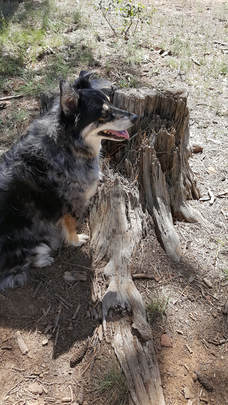 This is "Circle Elder," posing with my Border/Aussie best friend, Teak.
This is "Circle Elder," posing with my Border/Aussie best friend, Teak. Elder is not happy with me right now, because he reminded me all summer that he wants a painted rock but I haven't gotten it done yet.
I warned him that he won't have it for long. He lives near the gravel circle that visitors use to park their vehicles while they play in the forest.
So, any rock I put on him will be found and claimed by a visitor immediately. But he's insistent. Pushy, in fact.
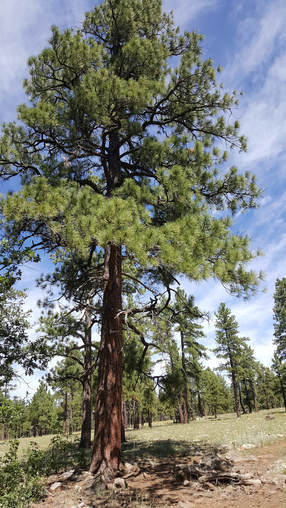 This tree calls himself "Sniffer." It's not a nickname I'd want, but this Pondarosa Pine says he secretly likes the fact that so many humans stop to smell his bark as they pass. He's in the center of a bend in the trail and so is quite accessible.
This tree calls himself "Sniffer." It's not a nickname I'd want, but this Pondarosa Pine says he secretly likes the fact that so many humans stop to smell his bark as they pass. He's in the center of a bend in the trail and so is quite accessible.I told him I love the vanilla scent of his bark.
He said, "I know. Come back earlier next spring when my sap is running, the scent is much stronger then."
He also asked why the dogs and I don't come to visit more during the winter months. Good question! I said we'd make a point to come up after the holidays, and see if we can make it right before a big snowstorm. Maybe we can get snowed in....
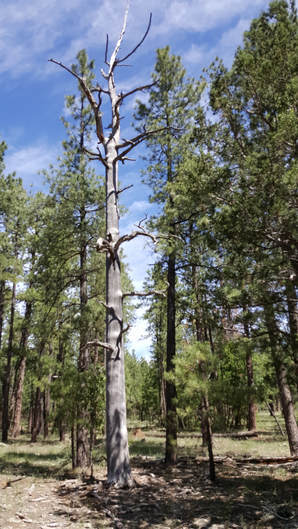 This is "Ghost", a new friend. He is off the beaten path, and not accustomed to interacting with humans as much as the previous ones.
This is "Ghost", a new friend. He is off the beaten path, and not accustomed to interacting with humans as much as the previous ones. I asked him how he died and he seemed confused and said he didn't remember what happened. He seems very lonely and says he can't communicate much with the surrounding trees,
Hmm. I'm looking forward to spending an extended time getting to know more about him, including his species. I don't think he's a pine--see, he has smooth bark.
This one will be a challenge.
 This is "Lantern Man." He is a big guy, with fully leafed branches higher up, and these strong, stubby branches at head height, perfect for hanging a lantern to light the trail.
This is "Lantern Man." He is a big guy, with fully leafed branches higher up, and these strong, stubby branches at head height, perfect for hanging a lantern to light the trail.No, he was not a victim of human pruning. He says he grew this way on purpose.
This tree is exceptionally friendly and outgoing. He stops me to say hello each time I pass. He's a happy guy, and I'm not surprised. Look at the beautiful setting around him, dappled sunlight, and the trail goes right under him. He's about three-quarters of a mile along this lightly-populated trail, so he gets enough company, but never a crowd.
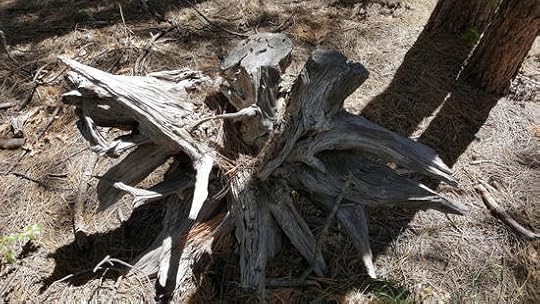 This crazy lady calls herself "Witchwood." The photo doesn't do her justice, she is a striking specimen. She is right across the trail from a very shady, fairy-glen type grove of trees that feels highly magical as well.
This crazy lady calls herself "Witchwood." The photo doesn't do her justice, she is a striking specimen. She is right across the trail from a very shady, fairy-glen type grove of trees that feels highly magical as well. I have left painted rocks in "Witchwood" and the adjacent glen three times this season. Every time, the rocks were gone when I went by the next day. Obviously she gets a lot of human attention. When I tried to visit with her, however, she told me to leave her alone.
Finding Your Tree
A simple way to begin to connect deeply with trees is to begin by selecting a species, and then finding an individual tree that calls to you. Different tree species work with different human energy patterns.
Like me, you may find that a specific species has already chosen you! When I starting spending time in Northern Arizona, I was sure that the quaking Aspens, with their golden fall leaves and white bark, would be my best friends.
When we built our cabin, I did a tree spirit blessing, asking the forest to accept their newest human neighbors and keep us safe. Part of that blessing included scattering seeds and corn around the perimeter of the property (the crows loved that part), and keeping a pine branch on the roof for a full moon cycle.
It must have worked. Ever since we moved in, the Ponderosa Pines have talked to me incessantly. It’s clear we’ve been adopted.
Be sure your tree is readily accessible. Pick a spot you like, and then pick your tree. You will want to visit it regularly and do so with minimal hardship, so pick a tree you have easy access to.
When you have found a tree, approach it slowly and allow the tree an opportunity to resist you. You may find you don’t feel comfortable there after all, and that’s okay. Move on. When you do find the right tree, take some time to get acquainted. Gently touch the leaves, and let the tree know you’d like to befriend it. Sometimes walking around the tree slowly clockwise, spiraling inward to the trunk, is a way to gently attract the tree spirit’s attention.
Touch its bark and spend some time standing against it. With your first few breaths, send your attention down into your feet to mingle with the tree’s roots. Then, on the next slow breath, send your attention into the trunk and upwards into the branches.
Close your eyes and listen. What do you hear? Breeze rustling through the canopy? Birds, and if so, what kind? Insects or other critters? This is your tree’s living environment. Enjoy the light and shadow, the movements. Note the pattern the branches form from your viewpoint.
Breathe out slowly again, sending your consciousness upward and downward. Don’t look for meaning or words, just let your consciousness totally absorb the scene around, above and beneath you. Acknowledge the divinity present here, and send your care and respect to the tree spirit before you.
Sometimes you come across a tree whose branches or trunks rub up against themselves or other trees, and when the wind is strong, they creak and bang. These are messenger trees, communicating audibly so that others can hear. Get to know one of these trees if you can. They often have a lot to say, and may be appointed “speakers of the forests.” Sit at the base of the trunk and let the creaking reverberate through your body. Put your ear to the trunk and hear the creaking through the tree. I find many messenger trees in the redwoods forests I’ve visited. In their case, you always want to listen to what they say, as their message is oftentimes, “Look up! Part of me is falling!”
It’s also interesting to examine your tree for its face—nearly every tree has one. Usually somewhere on the bark, there are full or partial facial features. Some say that the location of the tree’s face gives a sense of the tree’s accessibility and friendliness. Well off the ground means the tree prefers not to be approached. I don’t know if that’s true, I’d try talking to it anyway.
If you have some idea how long this tree has been alive, you may try opening your mind to its lifespan and see if it tells you its story.
Invite the tree to be your ally and spirit companion, and ask it to communicate to you any needs it may have, and any way it would like to be communicated with. Does your tree have a secret name it would like to share?
Ask it to guide you in your understanding of trees and tree spirits. Pay attention to any images you receive in your mind’s eye, in addition to any other promptings or feelings. You may not get any answers right now, but it’s important to show your willingness to give it attention, support and care, just like you would give and receive with any friend.
Now you have a new friend! If you don’t know what species the tree is, may a point to consult a reference book and find out when leave. You may want to take a picture of your tree, or draw it in your sketch pad, including a detail of a leaf for reference.
Learn as much as you can about the role this tree plays in your local ecosystem. How was this tree used by humans in the past? Does it still have human uses? What are the features of its wood? How widespread is this species? Is it under threat of any kind? Is it native, naturalized, or considered invasive? Does the tree have any medicinal properties? Knowing the answers to these questions can really help you understand how past humans have worked with this tree (or taken from it).
Another important question to ask is: what is the mythology and magic of this tree? You may need to look to different cultural sources and references to get a full picture. Some trees, like apple, cypress, yew, oak, ash, hemlock, rowan, and many others, are present in both the old and the new world, so you can study the mythology of both.
There are some trees that guard themselves closely, or don’t have faces that are accesable. And there are a few species that have energy that is not compatible with humans—yew and elm are two such species, according Danu Forest, author of the book Celtic Tree Magic.
Also keep in mind the time of year you attempt your communications. Many trees are most active and engaged when their sap is running in the late winter/early spring, or when they are in full foliage in the summer months. As winter approaches, all the trees, even the pines, slow down a bit. You won’t be able to commune with deciduous trees in winter, they will be resting, their energies focused on the terrestrial currents of the land. But you should be able to work with the conifers and the oak all winter.
Develop this relationship consistently through weeks, months and years, visiting your tree at different times of day and night, and different seasons, until you are familiar with its life rhythms.
Published on August 31, 2018 20:08
August 24, 2018
Getting Acquainted with Urban Trees
 Would you like to talk with the trees in your neighborhood, and know what they are thinking and feeling?
Would you like to talk with the trees in your neighborhood, and know what they are thinking and feeling?First, know that the location of your tree will dictate how you approach it.
Urban trees are often a lot more “awake” than many of their forest counterparts, especially trees in parks and other well-tended places.
Think about it this way: in a remote forest, there are trees who have very likely never had any human interaction at all. A human has never touched them, never tried to speak with them.
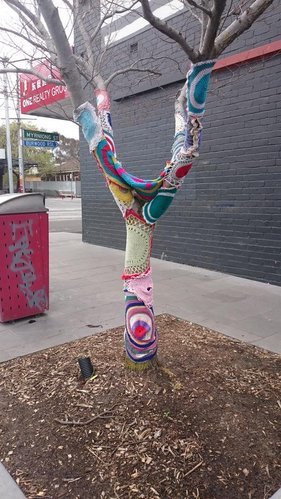 Urban trees, on the other hand, live surrounded by humans, were almost certainly planted by humans, watered by humans, and generally have regular human interaction.
Urban trees, on the other hand, live surrounded by humans, were almost certainly planted by humans, watered by humans, and generally have regular human interaction.
Photo credit: Squinert, Melbourne, Australia
A positive example is a tree in a local park or playground. Children play among these trees, climb them, make friends with them and hug them regularly. Adults often come to enjoy their shade, sit against them and read a book, or use them to hang up a hammock and more.
These trees are very open and friendly and are used to human interaction. These big guys are wonderful to talk and work with, and are a great place to start your tree talking.
 On the downside, some urban trees have experienced higher than necessary levels of trauma, and might be angry at humans.
On the downside, some urban trees have experienced higher than necessary levels of trauma, and might be angry at humans.Trees may have been visciously pruned, or had their branches broken for no reason, and this will make the trees, as a tribe, angry.
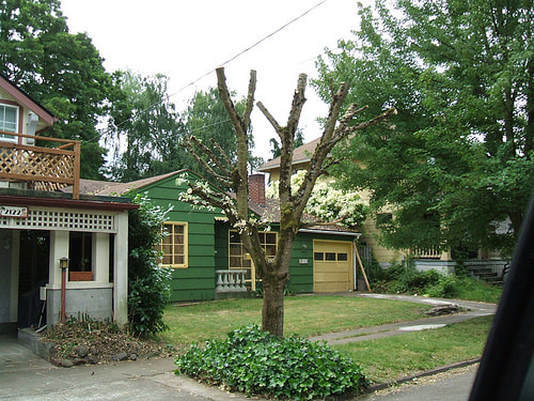 So you may find some angry or sullen trees who feel violated by humans, or who have lost good friends (lots of them) in an urban setting. These trees may not only refuse to speak, but will physically lash out, whacking people with branches, falling onto houses in a storm, tripping you and ripping out the sidewalk with roots.
So you may find some angry or sullen trees who feel violated by humans, or who have lost good friends (lots of them) in an urban setting. These trees may not only refuse to speak, but will physically lash out, whacking people with branches, falling onto houses in a storm, tripping you and ripping out the sidewalk with roots.For these trees, consider doing some land healing activities: Apologize for their bad treatment, witness and honor their pain, give them space but come around often to let them know there are good humans out there.
Urban trees have to withstand different demands than their forest counterparts. Pollution can be especially hard on certain species. For example, at one time, sugar maples were planted heavily in cities all over the United States.
 They’re beautiful trees, developing a wide canopy of cool, dense shade. In the fall, the leaves turn into a blaze of gold, orange and red. But the sugar maple is very sensitive to pollution, and as cities began generating more pollution with the advent of power plants, factories and automobiles, the sugar maples couldn’t survive. In smaller urban areas you can still find sugar maples, but they are relatively rare in larger cities now. Do you have any survivors where you live?
They’re beautiful trees, developing a wide canopy of cool, dense shade. In the fall, the leaves turn into a blaze of gold, orange and red. But the sugar maple is very sensitive to pollution, and as cities began generating more pollution with the advent of power plants, factories and automobiles, the sugar maples couldn’t survive. In smaller urban areas you can still find sugar maples, but they are relatively rare in larger cities now. Do you have any survivors where you live?For the sake of the tree tribe and the living trees, I think it’s good to honor the fallen trees. One of my favorite things to do involves taking charcoals and doing healing drawings and ogham rune work on the freshly cut stumps, and leaving little blessings, such as acorns, tobacco, lavender, dried corn. In fact, I fill my pockets with these little offerings each time I hike out into Nature, just in case I need it.
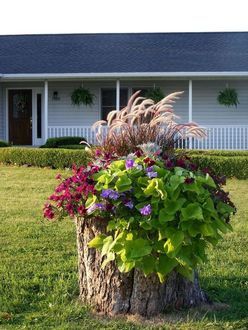 If the fallen tree is in your yard, don’t get rid of the stump—use it for a planter!
If the fallen tree is in your yard, don’t get rid of the stump—use it for a planter!You can even make a rune set from your favorite tree, and keep its spirit near you.
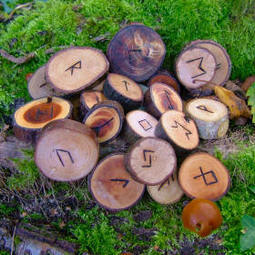 Figuring out what kind of typical interaction a tree has had with humans is a good start to developing a deeper relationship with that tree—and thinking about the tree’s daily life adds a deeper empathy to your life as well.
Figuring out what kind of typical interaction a tree has had with humans is a good start to developing a deeper relationship with that tree—and thinking about the tree’s daily life adds a deeper empathy to your life as well.Most urban trees these days, are not seen so much as living things, but as something to make the back yard less sunny or to increase the curb appeal of a neighborhood. Bringing them back in line with sacred practice, and recognizing their worth and sacredness, is important part of working with trees and all nature.
One of the things that has happened as humans became disconnected from nature is that the fruits and yields of our trees are no longer honored as they once were.
A century ago, any apple tree was a prized possession, used for raw treats, to make cider, pies and preserves—so prized that they were wassailed and carefully pruned each year to ensure abundant harvests.
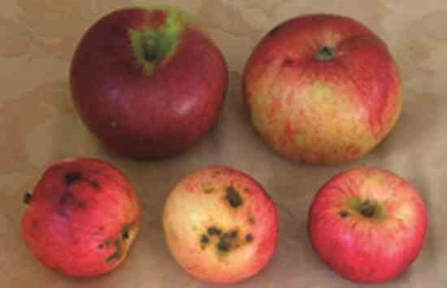 Now, people prefer to plant “dwarf” varies to “minimize the mess” because they don’t use the fruit.
Now, people prefer to plant “dwarf” varies to “minimize the mess” because they don’t use the fruit.The same fate has fallen on the citrus trees in Phoenix. Neighborhoods are infested with roof rats, who feed on the oranges that homeowners let drop, unused, in their yard.
Everyone wants to buy sterile olive trees, so they won’t bear fruit. And mesquite pods are usually raked up with the rest of the yard litter, when they could be ground into a nutritious—and gluten free—flour.
 Today, the abundance of our trees is often seen as a waste product. I have found incredible amounts of tree harvest thrown in trash bags at the curb.
Today, the abundance of our trees is often seen as a waste product. I have found incredible amounts of tree harvest thrown in trash bags at the curb. My oldest son, who lives in Wisconsin, moved into a new house and discovered his yard was filled with walnut trees, and the ground was covered with black walnuts. Rather than rake them up and throw them away, he did a little research. He found a source, a black walnut association that would pay him for the nuts. Run by the Amish, the association said they would husk the walnuts if Josh would bring them in. He spent a long weekend raking and loading nuts into the back of his pickup, and then hauling them to the collection site.
And this, friends, is what we need to do. It takes a little extra effort, and the pay is paltry or non-existent, but do it anyway.
We eat the tangelos we grow. The lemon tree is so prolific we can’t eat it all (I’m convinced that our years of ritual circles held in front of the lemon tree has given it super powers). We give a lot of it away, and we also slice lemons and freeze the slices, so we have fresh lemon for our tea and water year round. One year, we had a winter “snowbird” vacationing in our neighborhood. She rang the doorbell and asked if she could pick lemons, and brought round two delicious lemon pies the next day in return.
This year, for the first time, we had fruit on our hedge of sour cherry bushes at the cabin. I didn’t even have time to think about what to do with them; one of my book club friends asked if she could pick the bushes and make jam. You bet! I hope she was able to make enough to share next week.

Of course, I never have any trouble finding witches to take a pomegranate fruit from our tree in October. My scrawny little tree has supplied the fruit for many an altar. Yes, I occasionally eat one or put it in a salad too. Unfortunately, we rarely get a hard freeze in Phoenix, and that’s what’s needed to turn the pomegranate fruit that delectable deep red hue. So my seeds are often golden instead. But they taste fine.
The point is, what we don’t dishonor our tree friends by leaving their fruit and nuts on the ground to rot!
I believe that one of the best things we can do to really connect with urban trees is to recognize their yields, honor them by harvesting and using those yields, and plant some of their windfall. This is what sacred work is all about, right? It can become magical work as well, by making inks, applesauce, lemonade, and other tree-based items and food, or drink and seeds that are used to ritual or ceremonial purposes. Just as importantly, when you take the tree within you, you connect with that tree on a new level. You become intimate compadres.
Next week, I’m going to venture into the woods, and talk about forest and wild-growing trees. How to approach them to forge a relationship, inner listening and what to expect, tree faces and “messenger trees.”
Until then, go out and get better acquainted with a tree in your neighborhood! Blessed be.
Published on August 24, 2018 21:55
August 17, 2018
Living in the Forest
I’ve been thinking a lot about trees lately, ever since I got home from camp in Redwood State Park last month. The park is second-growth redwoods, so tall they turn the sunlight dappled in the afternoon. You can’t help but feel their presence. 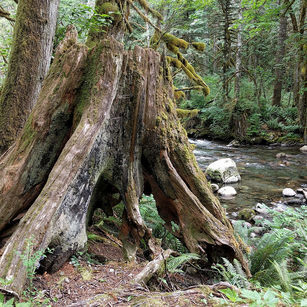 Throughout the park are the gigantic stumps of the original stand. The stumps are big enough you could curl up and sleep in them—and several campers actually hung hammocks from the stump edges and slept there. Many of the stumps also provide the base for the newer, second growth trees, so the forest feels ancient and wise, as if the new trees absorbed the knowledge of their predecessors. There’s a lot of magic in that redwood forest.
Throughout the park are the gigantic stumps of the original stand. The stumps are big enough you could curl up and sleep in them—and several campers actually hung hammocks from the stump edges and slept there. Many of the stumps also provide the base for the newer, second growth trees, so the forest feels ancient and wise, as if the new trees absorbed the knowledge of their predecessors. There’s a lot of magic in that redwood forest.
We live in a forest at our summer home in Northern Arizona. Our cabin backs up against the Coconino National Forest, so we are immersed in tree life. The vanilla scent of the Ponderosa pines wafts across the back porch in early morning.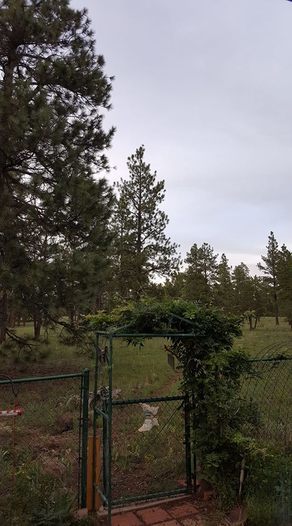 The raucous noise of the crows who gather in the trees at dawn, give way to the hummingbirds who zoom by us as we eat breakfast on the deck.
The raucous noise of the crows who gather in the trees at dawn, give way to the hummingbirds who zoom by us as we eat breakfast on the deck.
I feed the crows peanuts and the neighbors put a feeder out in the forest, so the crows are particularly attentive this summer. Unfortunately, so are the mother raccoon and her four babies.
The forest is, in fact, teeming with wildlife. My husband erected an infrared game camera at the edge of the forest. He and the neighbors keep the area stocked with water and a salt block. In the last month, our little feeding station has been visited by elk, pronghorn deer, a coyote, a grey fox, raccoons, rabbits and a small gang of javalina.
If you live in the forest in the West, fire is always in the back of your mind. This summer started with extreme drought conditions, and the forest fires in California have been some of the worst yet. We’ve had rain almost every afternoon here, but that brings lightning, a major cause of our forest fires.
We’ve had rain almost every afternoon here, but that brings lightning, a major cause of our forest fires.
The forest gives us advance warning of the inevitable afternoon storms. The trees sway as the wind starts, and their restless branches whisper, “rain, rain, rain.”
The ominous grey clouds begin to build up against each other to the north or east, giving me just enough time to gather the morning newspaper and move inside to feed my suddenly uneasy dog, Teak, some calming treats. Then lightning flashes and thunder booms, shaking the house and driving poor Teak into the laundry room, nose buried behind the laundry basket against the wall. The ratta tat tat of the rain on our tin roof follows right on the heels of the lightning. We’re in the mountains as well as the forest, at 6800’ elevation, and the storms are abrupt and ferocious.
Storms in our desert place in Phoenix are different, they usually start as a dust storm (see last week’s blog on haboobs). The trees in the desert are different too. They often don’t grow straight up. Instead, they twist themselves around like they’re trying to grow back into the ground. In a way they are; they’re growing aggressively toward their water source.
They often don’t grow straight up. Instead, they twist themselves around like they’re trying to grow back into the ground. In a way they are; they’re growing aggressively toward their water source.
These guys are survivors.
We also have citrus trees, a lemon and a tangelo. In the spring, our back yard is saturated with the sweet scent of their blossoms, along with the Juicy fruit-gum scent of a Texas Mountain Laurel, with its purple, Wisteria-like drooping blossoms.
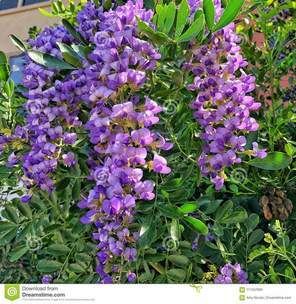 Every place I go, I’m reminded that we are all connected in a web of nature, and trees play such an important role in our planetary health. They provide the air we breathe, many fruits and foods, medicines, the wood we use to build our homes, the paper we make to print our books, beautiful sights and scents, and much more.
Every place I go, I’m reminded that we are all connected in a web of nature, and trees play such an important role in our planetary health. They provide the air we breathe, many fruits and foods, medicines, the wood we use to build our homes, the paper we make to print our books, beautiful sights and scents, and much more.
We speak to trees and they respond. We snuggle among their roots so they can comfort us, and we climb their branches and get a unique view of the world. We touch and smell their rough bark and feel a deeper bond with nature. We look up through their branches and see a dappled world beyond.
What is your favorite tree? Even the most urbane of us will have a tree we like the best, whether it’s a beautiful tree in the park or by the road, a special tree from childhood, or a favorite species.
At this point in my life, it’s hard to choose. The apple tree by my swing set when I was little. It taught me to love apples, right off the tree.
Or the huge, massive oak in the front yard of the first house I bought with my own money. I called that tree the squirrel condo, by the way, plenty of acorns to go around.
Maybe the beautiful maple tree at my grandparent’s house. The one I climbed every day after school. It knocked the breath out of me, so I couldn’t call for help, when I fell out one time. But I kept climbing.
Those mystical redwoods rank high on the list.
And, of course, the vanilla-scented Ponderosa pines I live with now. I’m so grateful I met them while I can still hike. The dogs are grateful also.
All around the world, trees hold a special position as totems of spiritual identity, as well as markers of our cultural heritage and qualities. The Welsh yew is a tree of national pride and has been a sign of cultural resistance, as well as the mysteries of Druidry. The Oak stands for strength, nobility, patience, and guardianship. With a root span as deep and spreading as the branches above, it is a living symbol of, “as above, so below.”
Legends of a “World Tree” abound in most cultures, such as the tree of Knowledge of Good and Evil in the Garden of Eden, the Tree of Life of the Hebrew Kabbalah, and the sacred oak groves of the Druids. The Yggdrasil World Ash Tree in Norse myth rises up from the center of the earth, its branches forming the heavens of the gods, and its roots striking down into hell, where a serpent is entwined at the world’s dark core.
For most any favorite tree you pick, there is likely a myth, a legend, a botanical or magical use.
In fact, our thoughts about trees has barely scratched their surface, so let’s continue next week. For the next blog, I think I’ll start looking for faces in the trees during my forest hikes. I’ll share those faces with you next week, along with how to find “messenger” trees, Celtic tree magic, and an ancient language derived from trees.
In the meantime, you can look for tree faces too. Take a picture, and show me what you find.
 Throughout the park are the gigantic stumps of the original stand. The stumps are big enough you could curl up and sleep in them—and several campers actually hung hammocks from the stump edges and slept there. Many of the stumps also provide the base for the newer, second growth trees, so the forest feels ancient and wise, as if the new trees absorbed the knowledge of their predecessors. There’s a lot of magic in that redwood forest.
Throughout the park are the gigantic stumps of the original stand. The stumps are big enough you could curl up and sleep in them—and several campers actually hung hammocks from the stump edges and slept there. Many of the stumps also provide the base for the newer, second growth trees, so the forest feels ancient and wise, as if the new trees absorbed the knowledge of their predecessors. There’s a lot of magic in that redwood forest.We live in a forest at our summer home in Northern Arizona. Our cabin backs up against the Coconino National Forest, so we are immersed in tree life. The vanilla scent of the Ponderosa pines wafts across the back porch in early morning.
 The raucous noise of the crows who gather in the trees at dawn, give way to the hummingbirds who zoom by us as we eat breakfast on the deck.
The raucous noise of the crows who gather in the trees at dawn, give way to the hummingbirds who zoom by us as we eat breakfast on the deck.I feed the crows peanuts and the neighbors put a feeder out in the forest, so the crows are particularly attentive this summer. Unfortunately, so are the mother raccoon and her four babies.
The forest is, in fact, teeming with wildlife. My husband erected an infrared game camera at the edge of the forest. He and the neighbors keep the area stocked with water and a salt block. In the last month, our little feeding station has been visited by elk, pronghorn deer, a coyote, a grey fox, raccoons, rabbits and a small gang of javalina.
If you live in the forest in the West, fire is always in the back of your mind. This summer started with extreme drought conditions, and the forest fires in California have been some of the worst yet.
 We’ve had rain almost every afternoon here, but that brings lightning, a major cause of our forest fires.
We’ve had rain almost every afternoon here, but that brings lightning, a major cause of our forest fires.The forest gives us advance warning of the inevitable afternoon storms. The trees sway as the wind starts, and their restless branches whisper, “rain, rain, rain.”
The ominous grey clouds begin to build up against each other to the north or east, giving me just enough time to gather the morning newspaper and move inside to feed my suddenly uneasy dog, Teak, some calming treats. Then lightning flashes and thunder booms, shaking the house and driving poor Teak into the laundry room, nose buried behind the laundry basket against the wall. The ratta tat tat of the rain on our tin roof follows right on the heels of the lightning. We’re in the mountains as well as the forest, at 6800’ elevation, and the storms are abrupt and ferocious.
Storms in our desert place in Phoenix are different, they usually start as a dust storm (see last week’s blog on haboobs). The trees in the desert are different too.
 They often don’t grow straight up. Instead, they twist themselves around like they’re trying to grow back into the ground. In a way they are; they’re growing aggressively toward their water source.
They often don’t grow straight up. Instead, they twist themselves around like they’re trying to grow back into the ground. In a way they are; they’re growing aggressively toward their water source. These guys are survivors.
We also have citrus trees, a lemon and a tangelo. In the spring, our back yard is saturated with the sweet scent of their blossoms, along with the Juicy fruit-gum scent of a Texas Mountain Laurel, with its purple, Wisteria-like drooping blossoms.
 Every place I go, I’m reminded that we are all connected in a web of nature, and trees play such an important role in our planetary health. They provide the air we breathe, many fruits and foods, medicines, the wood we use to build our homes, the paper we make to print our books, beautiful sights and scents, and much more.
Every place I go, I’m reminded that we are all connected in a web of nature, and trees play such an important role in our planetary health. They provide the air we breathe, many fruits and foods, medicines, the wood we use to build our homes, the paper we make to print our books, beautiful sights and scents, and much more.We speak to trees and they respond. We snuggle among their roots so they can comfort us, and we climb their branches and get a unique view of the world. We touch and smell their rough bark and feel a deeper bond with nature. We look up through their branches and see a dappled world beyond.
What is your favorite tree? Even the most urbane of us will have a tree we like the best, whether it’s a beautiful tree in the park or by the road, a special tree from childhood, or a favorite species.
At this point in my life, it’s hard to choose. The apple tree by my swing set when I was little. It taught me to love apples, right off the tree.
Or the huge, massive oak in the front yard of the first house I bought with my own money. I called that tree the squirrel condo, by the way, plenty of acorns to go around.
Maybe the beautiful maple tree at my grandparent’s house. The one I climbed every day after school. It knocked the breath out of me, so I couldn’t call for help, when I fell out one time. But I kept climbing.
Those mystical redwoods rank high on the list.
And, of course, the vanilla-scented Ponderosa pines I live with now. I’m so grateful I met them while I can still hike. The dogs are grateful also.
All around the world, trees hold a special position as totems of spiritual identity, as well as markers of our cultural heritage and qualities. The Welsh yew is a tree of national pride and has been a sign of cultural resistance, as well as the mysteries of Druidry. The Oak stands for strength, nobility, patience, and guardianship. With a root span as deep and spreading as the branches above, it is a living symbol of, “as above, so below.”
Legends of a “World Tree” abound in most cultures, such as the tree of Knowledge of Good and Evil in the Garden of Eden, the Tree of Life of the Hebrew Kabbalah, and the sacred oak groves of the Druids. The Yggdrasil World Ash Tree in Norse myth rises up from the center of the earth, its branches forming the heavens of the gods, and its roots striking down into hell, where a serpent is entwined at the world’s dark core.
For most any favorite tree you pick, there is likely a myth, a legend, a botanical or magical use.
In fact, our thoughts about trees has barely scratched their surface, so let’s continue next week. For the next blog, I think I’ll start looking for faces in the trees during my forest hikes. I’ll share those faces with you next week, along with how to find “messenger” trees, Celtic tree magic, and an ancient language derived from trees.
In the meantime, you can look for tree faces too. Take a picture, and show me what you find.
Published on August 17, 2018 17:54
August 11, 2018
AZ Weather in the Horse Latitudes
Before I moved to Arizona to live full-time, I thought the only serious weather issue was the temperature.
The Phoenix area is extremely hot. We average 110 days a year over 100 degrees, and it doesn’t cool off much at night. That heat is relentless.
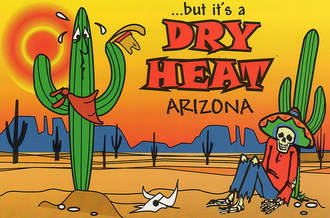 I’m sure you’ve seen the postcard.
I’m sure you’ve seen the postcard.
In early July, just when I feel I can’t take it anymore, I will scream if I see another temperature reading of 116 on my car dash, and I swear I’m moving someplace cold before next summer, something changes. Our single-digit humidity begins to creep up to 30% or more.
It’s the first hint that the monsoon season is coming to the desert.
I grew up in the Midwest and was used to lightning and thunderstorms. But when I experienced my first monsoon storm in Arizona, I discovered just how awe-inspiring life in the desert can be.
 Though the word monsoon is often misused to refer to a single long, drenching thunderstorm, it is actually the name given to a large-scale weather pattern. The word derives from the mausin, Arabic for “season” or “wind shift.”
Though the word monsoon is often misused to refer to a single long, drenching thunderstorm, it is actually the name given to a large-scale weather pattern. The word derives from the mausin, Arabic for “season” or “wind shift.”
Why does Phoenix have summer monsoons? Doesn’t it seems counter-intuitive to have the majority of the rainfall when the temperatures are the highest?
 The scientific answer lies in our distance from the equator. You see, we live on the edge of what is called the “horse latitudes,” two subtropical atmospheric high-pressure belts that encircle the Earth around latitudes 30 degrees North in the Northern hemisphere and 30 degrees South in the Southern hemisphere. The horse latitudes are those bands that sailors dread because their ships are becalmed when they hit these high-pressure belts of no wind and clear skies.
The scientific answer lies in our distance from the equator. You see, we live on the edge of what is called the “horse latitudes,” two subtropical atmospheric high-pressure belts that encircle the Earth around latitudes 30 degrees North in the Northern hemisphere and 30 degrees South in the Southern hemisphere. The horse latitudes are those bands that sailors dread because their ships are becalmed when they hit these high-pressure belts of no wind and clear skies.
Those high pressure ridges are the product of global air circulation known as the Hadley Cell. The air at the equator heats and rises to the lower atmosphere, where it diverges, moving away from the equator, both north and south, until it cools and sinks around the 30th parallel in both hemispheres. At the surface level, the sinking air diverges again with some returning from the equator, completing the Hadley circulation.
The end result is that little or no moisture ever reaches the ground below this climatological high-pressure area. Thus, the horse latitudes produce arid climates in the areas below them. The Sahara, for example, is situated in a horse latitude. So is our own Sonoran desert.
But luckily for us, we get a reprieve.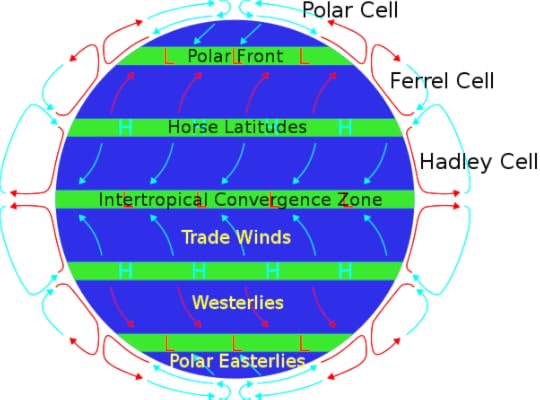 That the high pressure ridge starts migrating poleward in late spring. The ridge across North America typically migrates far enough northward to begin monsoon conditions across the Desert Southwest in July and continue through September.
That the high pressure ridge starts migrating poleward in late spring. The ridge across North America typically migrates far enough northward to begin monsoon conditions across the Desert Southwest in July and continue through September.
On average, Arizona gets about half of its annual rainfall during the summer monsoon.
 In addition, the wind shifts direction in the summer. Arizona winds usually come from the west, but they shift to southeasterly in the summer, bringing moisture up from the Gulf of Mexico.
In addition, the wind shifts direction in the summer. Arizona winds usually come from the west, but they shift to southeasterly in the summer, bringing moisture up from the Gulf of Mexico.
The wind shift and increase in moisture combine with the surface low pressure from the desert heat to produce storms in a cycle of “bursts” (heavy rainfall) and “breaks” (suddenly reduced rain).
 Before the rain, the wind shift can trigger dust storms known as haboobs, which appear as loose swirling walls of dust several hundred feet high. The name comes from the Arabic word habb, meaning “wind.” They’re formed when air is forced downward and pushed forward by the front of a thunderstorm cell, picking up dust as it travels across the desert.
Before the rain, the wind shift can trigger dust storms known as haboobs, which appear as loose swirling walls of dust several hundred feet high. The name comes from the Arabic word habb, meaning “wind.” They’re formed when air is forced downward and pushed forward by the front of a thunderstorm cell, picking up dust as it travels across the desert.
Driving through a haboob can be terrifying. Drivers are instructed to pull off the road, turn their lights off, and wait until it has passed.
The downpour from the monsoon thunderstorms spurs plant growth. Desert plants absorb moisture to sustain themselves after the wet season ends.
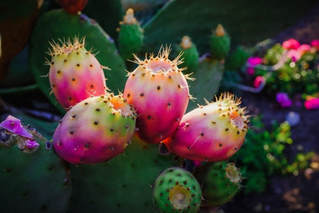 Prickly pear fruit ripens at this time, turning a dark shade of pink.
Prickly pear fruit ripens at this time, turning a dark shade of pink.
Every year I watch, amazed, as my trees grow tall and lush in the midst of such heat, and the plants in my landscape bloom in magenta, bright orange and red. Who knew the desert had such vibrant plant colors?
Who knew the desert had such vibrant plant colors?  Nothing like the delicate pastel pinks, white and lavender blooms of my Midwest yard.
Nothing like the delicate pastel pinks, white and lavender blooms of my Midwest yard.
The monsoon rains are always welcome, but also dangerous. Flooding and wind damage is common. All over Arizona, you will see dry riverbeds called washes. During monsoon season, these washes can fill with water very suddenly.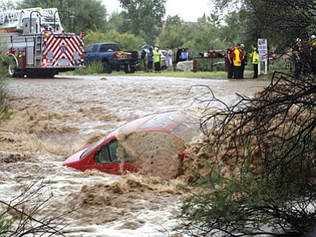 In fact, it may not even be raining where you are for a wash to fill with water, because the rainstorm may be happening upstream from you.
In fact, it may not even be raining where you are for a wash to fill with water, because the rainstorm may be happening upstream from you.
Every season, flash flooding happens and cars, people and even cattle become stranded or washed away.
Sadly, monsoon season also can make a tender box fire season even worse, due to the increased amount of lightning, up to tens of thousands of strikes per night in some areas.
Yes, life in the desert can be harsh. The unique weather patterns and monster storms remind me of the volatility of this rock we’re living on. The vivid bursts of plants, cacti and wildlife show how life can survive, and flourish, in the harshest environment. And the brief monsoon proves with stark reality how precious our water supply is to our survival.
Good lessons, all, don't you think?
The Phoenix area is extremely hot. We average 110 days a year over 100 degrees, and it doesn’t cool off much at night. That heat is relentless.
 I’m sure you’ve seen the postcard.
I’m sure you’ve seen the postcard.In early July, just when I feel I can’t take it anymore, I will scream if I see another temperature reading of 116 on my car dash, and I swear I’m moving someplace cold before next summer, something changes. Our single-digit humidity begins to creep up to 30% or more.
It’s the first hint that the monsoon season is coming to the desert.
I grew up in the Midwest and was used to lightning and thunderstorms. But when I experienced my first monsoon storm in Arizona, I discovered just how awe-inspiring life in the desert can be.
 Though the word monsoon is often misused to refer to a single long, drenching thunderstorm, it is actually the name given to a large-scale weather pattern. The word derives from the mausin, Arabic for “season” or “wind shift.”
Though the word monsoon is often misused to refer to a single long, drenching thunderstorm, it is actually the name given to a large-scale weather pattern. The word derives from the mausin, Arabic for “season” or “wind shift.”
Why does Phoenix have summer monsoons? Doesn’t it seems counter-intuitive to have the majority of the rainfall when the temperatures are the highest?
 The scientific answer lies in our distance from the equator. You see, we live on the edge of what is called the “horse latitudes,” two subtropical atmospheric high-pressure belts that encircle the Earth around latitudes 30 degrees North in the Northern hemisphere and 30 degrees South in the Southern hemisphere. The horse latitudes are those bands that sailors dread because their ships are becalmed when they hit these high-pressure belts of no wind and clear skies.
The scientific answer lies in our distance from the equator. You see, we live on the edge of what is called the “horse latitudes,” two subtropical atmospheric high-pressure belts that encircle the Earth around latitudes 30 degrees North in the Northern hemisphere and 30 degrees South in the Southern hemisphere. The horse latitudes are those bands that sailors dread because their ships are becalmed when they hit these high-pressure belts of no wind and clear skies.Those high pressure ridges are the product of global air circulation known as the Hadley Cell. The air at the equator heats and rises to the lower atmosphere, where it diverges, moving away from the equator, both north and south, until it cools and sinks around the 30th parallel in both hemispheres. At the surface level, the sinking air diverges again with some returning from the equator, completing the Hadley circulation.
The end result is that little or no moisture ever reaches the ground below this climatological high-pressure area. Thus, the horse latitudes produce arid climates in the areas below them. The Sahara, for example, is situated in a horse latitude. So is our own Sonoran desert.
But luckily for us, we get a reprieve.
 That the high pressure ridge starts migrating poleward in late spring. The ridge across North America typically migrates far enough northward to begin monsoon conditions across the Desert Southwest in July and continue through September.
That the high pressure ridge starts migrating poleward in late spring. The ridge across North America typically migrates far enough northward to begin monsoon conditions across the Desert Southwest in July and continue through September. On average, Arizona gets about half of its annual rainfall during the summer monsoon.
 In addition, the wind shifts direction in the summer. Arizona winds usually come from the west, but they shift to southeasterly in the summer, bringing moisture up from the Gulf of Mexico.
In addition, the wind shifts direction in the summer. Arizona winds usually come from the west, but they shift to southeasterly in the summer, bringing moisture up from the Gulf of Mexico. The wind shift and increase in moisture combine with the surface low pressure from the desert heat to produce storms in a cycle of “bursts” (heavy rainfall) and “breaks” (suddenly reduced rain).
 Before the rain, the wind shift can trigger dust storms known as haboobs, which appear as loose swirling walls of dust several hundred feet high. The name comes from the Arabic word habb, meaning “wind.” They’re formed when air is forced downward and pushed forward by the front of a thunderstorm cell, picking up dust as it travels across the desert.
Before the rain, the wind shift can trigger dust storms known as haboobs, which appear as loose swirling walls of dust several hundred feet high. The name comes from the Arabic word habb, meaning “wind.” They’re formed when air is forced downward and pushed forward by the front of a thunderstorm cell, picking up dust as it travels across the desert.
Driving through a haboob can be terrifying. Drivers are instructed to pull off the road, turn their lights off, and wait until it has passed.
The downpour from the monsoon thunderstorms spurs plant growth. Desert plants absorb moisture to sustain themselves after the wet season ends.
 Prickly pear fruit ripens at this time, turning a dark shade of pink.
Prickly pear fruit ripens at this time, turning a dark shade of pink. Every year I watch, amazed, as my trees grow tall and lush in the midst of such heat, and the plants in my landscape bloom in magenta, bright orange and red.
 Who knew the desert had such vibrant plant colors?
Who knew the desert had such vibrant plant colors?  Nothing like the delicate pastel pinks, white and lavender blooms of my Midwest yard.
Nothing like the delicate pastel pinks, white and lavender blooms of my Midwest yard.The monsoon rains are always welcome, but also dangerous. Flooding and wind damage is common. All over Arizona, you will see dry riverbeds called washes. During monsoon season, these washes can fill with water very suddenly.
 In fact, it may not even be raining where you are for a wash to fill with water, because the rainstorm may be happening upstream from you.
In fact, it may not even be raining where you are for a wash to fill with water, because the rainstorm may be happening upstream from you.Every season, flash flooding happens and cars, people and even cattle become stranded or washed away.
Sadly, monsoon season also can make a tender box fire season even worse, due to the increased amount of lightning, up to tens of thousands of strikes per night in some areas.
Yes, life in the desert can be harsh. The unique weather patterns and monster storms remind me of the volatility of this rock we’re living on. The vivid bursts of plants, cacti and wildlife show how life can survive, and flourish, in the harshest environment. And the brief monsoon proves with stark reality how precious our water supply is to our survival.
Good lessons, all, don't you think?
Published on August 11, 2018 14:03
August 2, 2018
July 28, 2018
Happy Lughnasadh!
 When summer is at its peak, when the berries are ripe for the picking, and when we are basking in the sun's warmth, it is time for a celebration.
When summer is at its peak, when the berries are ripe for the picking, and when we are basking in the sun's warmth, it is time for a celebration.Our ancient Celtic ancestors celebrated this time with a Sabbat they called Lughnasadh. Pronounced LOO-na-sa, this was the first harvest celebration of the year, and marked the time when the first round of crops would be harvested.
Widely observed throughout Ireland, Scotland, Wales and the Isle of Man, Lughnasadh was originally observed on July 31 or August 1, half-way between the summer solstice and autumn equinox.
Lughnasadh is one of the four Celtic seasonal festivals, along with
Samhain, Imbolc and Beltane. It corresponds to other European harvest festivals such as the English Lammas.
 Lughnasadh is said to have begun by the god Lugh as a funeral feast and athletic competition in commemoration of his mother, Tailtiu. She is said to have died of exhaustion after clearing the plains of Ireland for agriculture.
Lughnasadh is said to have begun by the god Lugh as a funeral feast and athletic competition in commemoration of his mother, Tailtiu. She is said to have died of exhaustion after clearing the plains of Ireland for agriculture.According to medieval writings, kings attended the games, and a truce was declared for its duration.
Trial marriages were also conducted, and young couples joined hands through a hole in a wooden door. The trial marriage lasted a year and a day, at which time the marriage could be made permanent or broken without consequences.
Lughnasadh customs are still being practiced in Ireland. The Irish climb their mountains in celebration, the most well-known being Reek Sunday—the yearly pilgrimage to the top of Croagh Patrick in late July, which attracts tens of thousands of pilgrims each year. In fact, the Catholic Church in Ireland established the custom of blessing fields at Lughnasadh.
At some gatherings, everyone wears flowers while climbing the hill, and then bury them at the summit as a sign that summer is ending. In other places, the first sheaf of the harvest wheat is buried.
Some Wiccans mark the sabbat by baking a figure of the “corn god” Lugh in bread, and then symbolically sacrificing and eating it. And in Hungary, public tables are set up at crossroads, containing fresh loaves of bread and glasses of wine.
Regardless of the exact ceremony, Lughnasadh is the time to give thanks to the spirits and deities for the beginning of the harvest season, and to welcome them with offerings. It’s the cross-quarter holiday commemorating the miracle of rebirth, remembered with gifts of the harvest—corn, berries, apples, grapes, and summer squashes.
So, as you visit an August county fair or a plentiful farmer’s market, remember that they are all remnants of the ancient celebrations of the prosperity of our beautiful earth.
Eating with focus on the food and hot on the TV or phone, is one way of expressing thanks for the harvest—all year round, but especially at Lughnasadh.
Published on July 28, 2018 22:37
July 21, 2018
Harry Potter for Grownups
 Happy birthday, J.K. Rowling and Harry Potter!
Happy birthday, J.K. Rowling and Harry Potter!The author of the beloved fantasy novel series turns 52 on July 31. She shares her birthday with her most famous character, The Boy Who Lived.
If you haven’t read the Harry Potter series since the first time your child picked it up, it’s easy to miss many of the references J.K. Rowling packed into her books. One of the joys of revisiting the series as an adult is finding all the mythological, allegorical and historical references she scattered throughout the pages.
First, there are the more obvious references. Most people are familiar with the sphinx, for example. "Minerva" was the Roman goddess of wisdom. And Fluffy looks an awful lot like Cerberus, the three-headed dog who guarded the Ancient Greek underworld.
But below are some tidbits you are more likely to have missed. Snape’s Hidden Message
Rowling is a master of subtext: the meaning beneath the dialogue; what the speaker really means, even though he’s not saying it directly.
 Photo by Annie Leibowitz
Photo by Annie LeibowitzConsider, for example, this conversation between Severus Snape and Harry Potter during their first Potions class. Snape asked Harry a series of questions, including this clue: “Mr. Potter. Tell me, what would I get if I added powered root of asphodel to an infusion of wormwood?” Of course, Harry, being new to the wizarding world, had no idea.
According to the Victorian language of flowers, asphodel is a type of lily meaning “my regrets follow you to the grave” and wormwood means “absence” and symbolizes bitter sorrow. If we combine the meanings of those two plants, we could interpret the truth behind Snape’s question as, “I bitterly regret Lily’s death.”
Cold-hearted as Severus Snape might have been, readers eventually discover that he’s been in love with Lilly Potter for all of his adult life. In fact, this failed love story is the catalyst of Snape’s entire character arc, and it’s the painful seed that grows the complicated relationship between Harry Potter and himself.
Rowling gives us the first clue early on. Of course, deciphering it requires a working knowledge of Victorian flower meanings.
Along that same line…
 The Wizarding World Plants Come from a Real Book
The Wizarding World Plants Come from a Real Book“I used to collect names of plants that sounded witchy,” Rowling told 60 Minutes, “and then I found Culpeper’s Complete Herbal, the answer to my prayer.
First published over 350 years ago during the reign of Elizabeth I, Culpeper's Herbal remains one of the most complete listings of herbs and their uses in existence. From Adder's Tongue to Yarrow, the book contains plant descriptions and old-time uses.
To give a few examples:
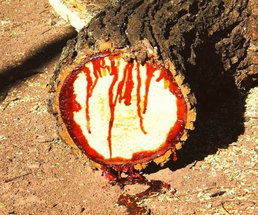 Dragon’s blood. While truly the bright red described in Half-Blood Prince, it’s not from dragons. It’s the resin exuded from the wounded trunk of the Dracaena draco tree, found in Morocco. The resin’s exquisite scent is often used in soaps and such.
Dragon’s blood. While truly the bright red described in Half-Blood Prince, it’s not from dragons. It’s the resin exuded from the wounded trunk of the Dracaena draco tree, found in Morocco. The resin’s exquisite scent is often used in soaps and such. Wormwood. One of the ingredients Harry Potter students use to make the Draught of Living Death, wormwood is used to make the alcoholic spirit Absinthe.
Wormwood. One of the ingredients Harry Potter students use to make the Draught of Living Death, wormwood is used to make the alcoholic spirit Absinthe.Absinthe has been portrayed through the years as a dangerously addictive psychoactive and hallucinogen, and it was banned in the 1900s. More recent studies have shown Absinthe’s psychoactive properties have been exaggerated, and it has enjoyed a revival since the 1990s.
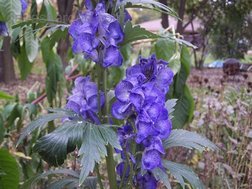 Severus Snape used Wolfsbane to treat Remus Lupin when that character turned into a werewolf.
Severus Snape used Wolfsbane to treat Remus Lupin when that character turned into a werewolf.That’s the folk-remedy name for the real-life herb Aconite. Folklore says this virulently poisonous herb could be added to sachets to guard against vampires and werewolves.
 The screaming Mandrakes who made their appearance in the Chamber of Secrets, really do make a scream-like noise when uprooted.
The screaming Mandrakes who made their appearance in the Chamber of Secrets, really do make a scream-like noise when uprooted. And yes, the dried roots do often look like people. They have long been used as magical poppets for home protection.
Wand Maker Ollivander Chose Carefully
The main threesomes’ wands are actually connected to the Celtic Tree Calendar. The Druidic calendar assigns letters in the Celtic Ogham alphabet to correspond to a specific tree each month.
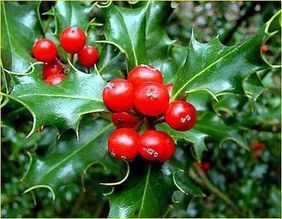 First, we have Harry, whose birthday is July 31, which corresponds to Holly, his wand wood.
First, we have Harry, whose birthday is July 31, which corresponds to Holly, his wand wood. This evergreen plant is protective and reminds us of the immortality of nature. People born under Holly are natural-born leaders.
Ron’s wand is Ash, which matches his wand and March 1 Birthday
Hermione’s birthday of Sept. 19 corresponds to her vine wood wand.
 For whatever reason, Rowling did not choose to have Voldemort’s Yew wand match his birth date of December 31.
For whatever reason, Rowling did not choose to have Voldemort’s Yew wand match his birth date of December 31. Personally, I think she wanted the Yew associations of death. Yew is poisonous. Every part of the tree contains alkaloids that are fatal to humans. And Yew remains poisonous after the tree has died. Similarly, Voldemort’s Horcruxes and Death Eaters lingered on after his demise at Godric’s Hollow, poisoning minds and destroying lives. The Author Put her Classics Degree to Use
Almost all of the spells in her wizarding world play around with Latin, and pretty much every creature and character name has some hidden significance. Here are some of the historical and mythological references in the Harry Potter books I found clever:
Expelliarmus, the spell to knock a weapon from an enemy’s hand, combines expellere, meaning “drive out” or “expel,” with arma, meaning “weapon.” Incendio, which lights a fire, comes from incendiaries, or “fire-raising.”
Likewise, the curse to kill Harry’s parents, “Avada Kedavra,” is an ancient spell in Aramaic, and the origin of abracadabra, which “let the thing be destroyed.”
And Hogwart’s motto is Draco Dormiens Numquam Titilandus—“Never Tickle a Sleeping Dragon.”
 The Death Eaters were originally known as the Knights of Walpurgis, which is a reversal of “Walpurgis Night,” the name of an old witch’s holiday on April 30th celebrating the rites of spring—exactly six months from Samhain (Halloween). On both nights, spirits were free to arise from their graves and roam.
The Death Eaters were originally known as the Knights of Walpurgis, which is a reversal of “Walpurgis Night,” the name of an old witch’s holiday on April 30th celebrating the rites of spring—exactly six months from Samhain (Halloween). On both nights, spirits were free to arise from their graves and roam.Hermione’s unique name comes from a Shakespeare play, The Winter’s Tale, but Rowling says the etymology was her inspiration. The name is a female derivative of Hermes, best known as the messenger of the Greek Gods. Hermes was also the god of eloquence, wit and quick-thinking, traits Hermione has in spades.
 Rowling said her favorite beast in the series is the phoenix, a mythical sacred bird who ignites into flames when it reaches 1,000 years old, only to emerge from the flames as a new, young version. My favorite is the Thestral, a breed of winged horse with a skeletal body, reptilian face, and wide, leathery wings like a bat.
Rowling said her favorite beast in the series is the phoenix, a mythical sacred bird who ignites into flames when it reaches 1,000 years old, only to emerge from the flames as a new, young version. My favorite is the Thestral, a breed of winged horse with a skeletal body, reptilian face, and wide, leathery wings like a bat.  Thestrals got a bad rap in the books, and became known as omens of misfortune and death because they are visible only to those who have witnessed death. What I found most interesting was how Rowling used the Thestrals to distinguish people who have witnessed the process of dying, as opposed to those who have only seen the resulting death. Those who have witnessed life ending will forever see life differently.
Thestrals got a bad rap in the books, and became known as omens of misfortune and death because they are visible only to those who have witnessed death. What I found most interesting was how Rowling used the Thestrals to distinguish people who have witnessed the process of dying, as opposed to those who have only seen the resulting death. Those who have witnessed life ending will forever see life differently.Behind the Scenes
Daniel Radcliffe has been very open in the past about his struggles with alcohol. He admitted to Playboy Magazine that he drank heavily between the ages of 18 and 20. He said his life went off the rails for a while when he turned 18 and was filming Harry Potter and the Half-Blood Prince.
“People with problems like that are very adept at hiding it,” he said. “I can honestly say I never drank at work on Harry Potter. But I went into work still drunk. I can point to many scenes where I’m just gone. Dead behind the eyes.
Realizing he had to change his ways, Radcliffe quite drinking a month after filming the final Potter film, and still doesn’t drink.
 Dame Maggie Smith, the actress who played Professor McGonagall, filmed Harry Potter and the Half-Blood Prince while undergoing radiotherapy for breast cancer. “I was hairless. I had no problem getting the wig on,” she said. “I was like a boiled egg.”
Dame Maggie Smith, the actress who played Professor McGonagall, filmed Harry Potter and the Half-Blood Prince while undergoing radiotherapy for breast cancer. “I was hairless. I had no problem getting the wig on,” she said. “I was like a boiled egg.”Despite the jokes, filming the last HP films were a struggle for the actress, who has since been cancer-free.
On a lighter note, Daniel Radcliffe broke about 80 wands during the filming of the Harry Potter movies because he used them as drumsticks.
 Lastly, J.K. Rowling says one of the creatures in the books are based on her own struggles with depression after her mother’s death from multiple sclerosis in 1990.
Lastly, J.K. Rowling says one of the creatures in the books are based on her own struggles with depression after her mother’s death from multiple sclerosis in 1990. She used her experience to create Dementors, creepy creatures that feed on human emotion. “It's so difficult to describe [depression] to someone who's never been there, because it's not sadness," Rowling told Oprah Winfrey. “I know sadness. Sadness is to cry and to feel. But it's that cold absence of feeling—that really hollowed-out feeling. That's what Dementors are.”
If you could ask J.K. Rowling one question, what would it be? Do you have a little-known Harry Potter fact I didn’t mention? I'd love to hear about them.
Until next week, here's an idea: go back and re-read the whole Harry Potter series. Let me know what revelations they bring you!
Published on July 21, 2018 12:38
July 14, 2018
Workspace Quirks
I’ve read a hundreds of articles on de-cluttering your home, and almost as many on creating a calm and productive work space.
But here’s the rub: Unless you’re moving into a custom-built home, you have no choice about the physical space you have to work with. You have to get creative within the confines of your room.
During the summer months I live at two homes: Our permanent house in Phoenix, and our summer cabin in the woods at Munds Park, three hours away.
I spent some time walking through both homes this week, and looking at them with fresh eyes. I tried to just take everything in and simply observe. Then I asked myself: How does this home make you feel?
Kitchen Table - Phoenix It’s my happy space. I drink morning coffee here, surrounded by dogs and usually with a 20-pound black cat or two beside the laptop in front of me. It’s a sunny, open-feeling space. When the dogs go outside, I can watch them play (and, unfortunately, poop) through the bay window behind me.
I work on my laptop here a lot. A LOT. My son Ian hates this habit, because he Christmas-gifted me double monitors and a docking station upstairs in my office (where I’m supposed to be working). He nags me to clear off the kitchen table so we can eat there without my mess. I think he’s hurt that I don’t appreciate and use his gifts. Rightfully so.
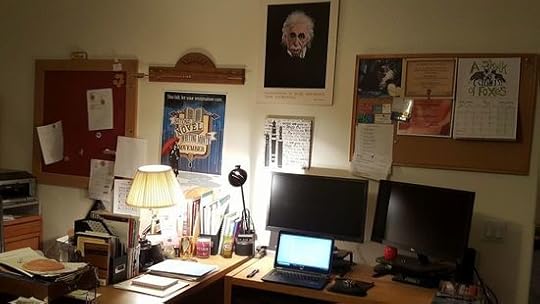 Do I feel guilty? No. The kitchen is where the action is. The pets would have to choose whether to go upstairs with me, or stay here in hopes of an occasional table scraps. Besides, I’d have to walk those stairs twenty times a day, and my knees are 60.
Do I feel guilty? No. The kitchen is where the action is. The pets would have to choose whether to go upstairs with me, or stay here in hopes of an occasional table scraps. Besides, I’d have to walk those stairs twenty times a day, and my knees are 60.
Solution: Move your butt upstairs girl!
*Do a fall cleaning on the filing cabinets to make space for all of your working files.
*Clear the desk off completely and add a green plant. The cat will have room to lay beside you, and he will come because he’s glued to your work space.
* Put a dog treat or favorite bone in the dog crates (on opposite side of room, not shown in the photo). They’ll come too, especially if the windows and blinds are open so they can survey the back yard.
* Add a fan for better circulation, it gets hot in the afternoon.
* Add music, large water bottle, and healthy snacks. You won’t have to go downstairs as often.
2. Kitchen Table - Cabin
I have picked up the same bad habit of working at the kitchen table in the cabin also. Up there, it’s for a different reason: I love to be able to look out at the forest while I’m working. But it’s distracting, and so is the TV which Paul watches at the other side of the room. I have a combo office space here as well, but haven’t been using it.
First, we had to add a slide out tray for my keyboard because the built-in corner desk was too tall. And there’s not enough lighting. The entire room is dimly lit. The corner desk feels claustrophobic, and there is little actual desk space that’s usable.
Solution: Re-arrange the room and add lighting. Add a side section/credenza to the desk.
* The desk light we bought doesn’t cut it, so Paul is going to install an under-cabinet light that will shine down on the back of my desk without glaring in my eyes. I’m also adding a tall desk lamp in the wasted space at the back of the corner desk’s “pie” shape. I have a stacked file holder back there now, and a project calendar on the wall, but it’s too dark to see them.
*I’m going to re-arrange furniture and either move the sewing machine table or use it as a credenza. Also moving the huge clunky printer so it’s not wedged in right next to the desk. It blocks the light the desk could get from the double window.
*Add a small fan for air circulation.
*Leave blinds up in double windows, and install ceiling hangers to hang a plant in each window.
*Clean up and deodorize the breezeway room next to the office. Open the screen door and windows in breezeway for added airflow. Maybe even figure out how those two rooms can be used together for space in the summer (breezeway is too cold in the winter).
Once I’ve made these changes, the key will be to keep the areas organized, not let my work “spill out” into other spaces around the house.
Employees of Disney properties go through an extensive training at Disney University. One of the things they are taught: If you pass one tiny piece of paper on the ground without picking it up, you’re fired.
Disney has figured out two things. First, it takes less human resources to keep the park clean if it’s kept spotless from the get-go. And second, both employees and guests will take pride in the cleanliness code and help to enforce it. Think about it. Where are you more inclined to throw a gum wrapper—on totally clean grounds or somewhere where there’s trash already?
I think the same “code” will be true in my offices. If I leave unfinished, unorganized “stuff” lying around, it will grow exponentially until there’s chaos.
I’m adding a physical in-tray to each office. I’m also going to have a “Master To Do” list at each office, to keep me aware of the big picture, and not have to recall everything from memory. Actually, I do this list already, but I don’t keep it out on my desk, it just gets written and filed away. Usually I find it a year later when I’m making the next annual master list.
No more! From my master “To Do” list (on my desk now!) I’m going to pull a daily chore list. (I also do this already, but on a much too ambitious scale. It ends up being a source of added stress since I never get everything crossed off in a day.)
Now I’m going to start by pulling 5 tasks I’m pretty certain I can get done. That will probably not be nearly everything I think I should get done in a given day, so it will be necessary to prioritize—and stay on task—ruthlessly.
Before I stop my work for the day and go into evening relaxation, I’ll review the day’s list, and finish what I didn’t accomplish. THEN, I’ll write the following day’s list of tasks. Then dinner and some relaxation time.
Because filing and shredding tends to be a task I despise and tend to fall behind on, I’m going to take a tip from David Allen’s “Getting Things Done” best-seller. He suggests designating one day a week for those tidying-up tasks that may have slipped through the cracks. These chores will be in place of, not in addition to, your 5 daily tasks.
Since I’m going to have separate lists for work and personal, I think I’ll put “vacuum” and “clean toilets” on that designated day as well.
Sounds easy here. I doubt it will be. Controlling clutter—or rather, lack of control—has been a big stressor for me for years. Now that I have two homes to maintain, and a husband who refuses to hire help at either place, I’m constantly stressed about the messy state of my home(s). If these organizational changes actually help, I will be one happy writer!
If you have other tips for organizing your work space, or your life in general, I’d love to hear them. Please leave your comments here, or look for this blog post on my Facebook page (Sandy Wright) and comment there.
Blessed be. And may your home be a peaceful and productive space!
But here’s the rub: Unless you’re moving into a custom-built home, you have no choice about the physical space you have to work with. You have to get creative within the confines of your room.
During the summer months I live at two homes: Our permanent house in Phoenix, and our summer cabin in the woods at Munds Park, three hours away.
I spent some time walking through both homes this week, and looking at them with fresh eyes. I tried to just take everything in and simply observe. Then I asked myself: How does this home make you feel?
Kitchen Table - Phoenix It’s my happy space. I drink morning coffee here, surrounded by dogs and usually with a 20-pound black cat or two beside the laptop in front of me. It’s a sunny, open-feeling space. When the dogs go outside, I can watch them play (and, unfortunately, poop) through the bay window behind me.
I work on my laptop here a lot. A LOT. My son Ian hates this habit, because he Christmas-gifted me double monitors and a docking station upstairs in my office (where I’m supposed to be working). He nags me to clear off the kitchen table so we can eat there without my mess. I think he’s hurt that I don’t appreciate and use his gifts. Rightfully so.
 Do I feel guilty? No. The kitchen is where the action is. The pets would have to choose whether to go upstairs with me, or stay here in hopes of an occasional table scraps. Besides, I’d have to walk those stairs twenty times a day, and my knees are 60.
Do I feel guilty? No. The kitchen is where the action is. The pets would have to choose whether to go upstairs with me, or stay here in hopes of an occasional table scraps. Besides, I’d have to walk those stairs twenty times a day, and my knees are 60.Solution: Move your butt upstairs girl!
*Do a fall cleaning on the filing cabinets to make space for all of your working files.
*Clear the desk off completely and add a green plant. The cat will have room to lay beside you, and he will come because he’s glued to your work space.
* Put a dog treat or favorite bone in the dog crates (on opposite side of room, not shown in the photo). They’ll come too, especially if the windows and blinds are open so they can survey the back yard.
* Add a fan for better circulation, it gets hot in the afternoon.
* Add music, large water bottle, and healthy snacks. You won’t have to go downstairs as often.
2. Kitchen Table - Cabin
I have picked up the same bad habit of working at the kitchen table in the cabin also. Up there, it’s for a different reason: I love to be able to look out at the forest while I’m working. But it’s distracting, and so is the TV which Paul watches at the other side of the room. I have a combo office space here as well, but haven’t been using it.
First, we had to add a slide out tray for my keyboard because the built-in corner desk was too tall. And there’s not enough lighting. The entire room is dimly lit. The corner desk feels claustrophobic, and there is little actual desk space that’s usable.
Solution: Re-arrange the room and add lighting. Add a side section/credenza to the desk.
* The desk light we bought doesn’t cut it, so Paul is going to install an under-cabinet light that will shine down on the back of my desk without glaring in my eyes. I’m also adding a tall desk lamp in the wasted space at the back of the corner desk’s “pie” shape. I have a stacked file holder back there now, and a project calendar on the wall, but it’s too dark to see them.
*I’m going to re-arrange furniture and either move the sewing machine table or use it as a credenza. Also moving the huge clunky printer so it’s not wedged in right next to the desk. It blocks the light the desk could get from the double window.
*Add a small fan for air circulation.
*Leave blinds up in double windows, and install ceiling hangers to hang a plant in each window.
*Clean up and deodorize the breezeway room next to the office. Open the screen door and windows in breezeway for added airflow. Maybe even figure out how those two rooms can be used together for space in the summer (breezeway is too cold in the winter).
Once I’ve made these changes, the key will be to keep the areas organized, not let my work “spill out” into other spaces around the house.
Employees of Disney properties go through an extensive training at Disney University. One of the things they are taught: If you pass one tiny piece of paper on the ground without picking it up, you’re fired.
Disney has figured out two things. First, it takes less human resources to keep the park clean if it’s kept spotless from the get-go. And second, both employees and guests will take pride in the cleanliness code and help to enforce it. Think about it. Where are you more inclined to throw a gum wrapper—on totally clean grounds or somewhere where there’s trash already?
I think the same “code” will be true in my offices. If I leave unfinished, unorganized “stuff” lying around, it will grow exponentially until there’s chaos.
I’m adding a physical in-tray to each office. I’m also going to have a “Master To Do” list at each office, to keep me aware of the big picture, and not have to recall everything from memory. Actually, I do this list already, but I don’t keep it out on my desk, it just gets written and filed away. Usually I find it a year later when I’m making the next annual master list.
No more! From my master “To Do” list (on my desk now!) I’m going to pull a daily chore list. (I also do this already, but on a much too ambitious scale. It ends up being a source of added stress since I never get everything crossed off in a day.)
Now I’m going to start by pulling 5 tasks I’m pretty certain I can get done. That will probably not be nearly everything I think I should get done in a given day, so it will be necessary to prioritize—and stay on task—ruthlessly.
Before I stop my work for the day and go into evening relaxation, I’ll review the day’s list, and finish what I didn’t accomplish. THEN, I’ll write the following day’s list of tasks. Then dinner and some relaxation time.
Because filing and shredding tends to be a task I despise and tend to fall behind on, I’m going to take a tip from David Allen’s “Getting Things Done” best-seller. He suggests designating one day a week for those tidying-up tasks that may have slipped through the cracks. These chores will be in place of, not in addition to, your 5 daily tasks.
Since I’m going to have separate lists for work and personal, I think I’ll put “vacuum” and “clean toilets” on that designated day as well.
Sounds easy here. I doubt it will be. Controlling clutter—or rather, lack of control—has been a big stressor for me for years. Now that I have two homes to maintain, and a husband who refuses to hire help at either place, I’m constantly stressed about the messy state of my home(s). If these organizational changes actually help, I will be one happy writer!
If you have other tips for organizing your work space, or your life in general, I’d love to hear them. Please leave your comments here, or look for this blog post on my Facebook page (Sandy Wright) and comment there.
Blessed be. And may your home be a peaceful and productive space!
Published on July 14, 2018 18:35
Worrkspace Quirks
I’ve read a hundreds of articles on de-cluttering your home, and almost as many on creating a calm and productive work space.
But here’s the rub: Unless you’re moving into a custom-built home, you have no choice about the physical space you have to work with. You have to get creative within the confines of your room.
During the summer months I live at two homes: Our permanent house in Phoenix, and our summer cabin in the woods at Munds Park, three hours away.
I spent some time walking through both homes this week, and looking at them with fresh eyes. I tried to just take everything in and simply observe. Then I asked myself: How does this home make you feel?
Kitchen Table - Phoenix It’s my happy space. I drink morning coffee here, surrounded by dogs and usually with a 20-pound black cat or two beside the laptop in front of me. It’s a sunny, open-feeling space. When the dogs go outside, I can watch them play (and, unfortunately, poop) through the bay window behind me.
I work on my laptop here a lot. A LOT. My son Ian hates this habit, because he Christmas-gifted me double monitors and a docking station upstairs in my office (where I’m supposed to be working). He nags me to clear off the kitchen table so we can eat there without my mess. I think he’s hurt that I don’t appreciate and use his gifts. Rightfully so.
 Do I feel guilty? No. The kitchen is where the action is. The pets would have to choose whether to go upstairs with me, or stay here in hopes of an occasional table scraps. Besides, I’d have to walk those stairs twenty times a day, and my knees are 60.
Do I feel guilty? No. The kitchen is where the action is. The pets would have to choose whether to go upstairs with me, or stay here in hopes of an occasional table scraps. Besides, I’d have to walk those stairs twenty times a day, and my knees are 60.
Solution: Move your butt upstairs girl!
*Do a fall cleaning on the filing cabinets to make space for all of your working files.
*Clear the desk off completely and add a green plant. The cat will have room to lay beside you, and he will come because he’s glued to your work space.
* Put a dog treat or favorite bone in the dog crates (on opposite side of room, not shown in the photo). They’ll come too, especially if the windows and blinds are open so they can survey the back yard.
* Add a fan for better circulation, it gets hot in the afternoon.
* Add music, large water bottle, and healthy snacks. You won’t have to go downstairs as often.
2. Kitchen Table - Cabin
I have picked up the same bad habit of working at the kitchen table in the cabin also. Up there, it’s for a different reason: I love to be able to look out at the forest while I’m working. But it’s distracting, and so is the TV which Paul watches at the other side of the room. I have a combo office space here as well, but haven’t been using it.
First, we had to add a slide out tray for my keyboard because the built-in corner desk was too tall. And there’s not enough lighting. The entire room is dimly lit. The corner desk feels claustrophobic, and there is little actual desk space that’s usable.
Solution: Re-arrange the room and add lighting. Add a side section/credenza to the desk.
* The desk light we bought doesn’t cut it, so Paul is going to install an under-cabinet light that will shine down on the back of my desk without glaring in my eyes. I’m also adding a tall desk lamp in the wasted space at the back of the corner desk’s “pie” shape. I have a stacked file holder back there now, and a project calendar on the wall, but it’s too dark to see them.
*I’m going to re-arrange furniture and either move the sewing machine table or use it as a credenza. Also moving the huge clunky printer so it’s not wedged in right next to the desk. It blocks the light the desk could get from the double window.
*Add a small fan for air circulation.
*Leave blinds up in double windows, and install ceiling hangers to hang a plant in each window.
*Clean up and deodorize the breezeway room next to the office. Open the screen door and windows in breezeway for added airflow. Maybe even figure out how those two rooms can be used together for space in the summer (breezeway is too cold in the winter).
Once I’ve made these changes, the key will be to keep the areas organized, not let my work “spill out” into other spaces around the house.
Employees of Disney properties go through an extensive training at Disney University. One of the things they are taught: If you pass one tiny piece of paper on the ground without picking it up, you’re fired.
Disney has figured out two things. First, it takes less human resources to keep the park clean if it’s kept spotless from the get-go. And second, both employees and guests will take pride in the cleanliness code and help to enforce it. Think about it. Where are you more inclined to throw a gum wrapper—on totally clean grounds or somewhere where there’s trash already?
I think the same “code” will be true in my offices. If I leave unfinished, unorganized “stuff” lying around, it will grow exponentially until there’s chaos.
I’m adding a physical in-tray to each office. I’m also going to have a “Master To Do” list at each office, to keep me aware of the big picture, and not have to recall everything from memory. Actually, I do this list already, but I don’t keep it out on my desk, it just gets written and filed away. Usually I find it a year later when I’m making the next annual master list.
No more! From my master “To Do” list (on my desk now!) I’m going to pull a daily chore list. (I also do this already, but on a much too ambitious scale. It ends up being a source of added stress since I never get everything crossed off in a day.)
Now I’m going to start by pulling 5 tasks I’m pretty certain I can get done. That will probably not be nearly everything I think I should get done in a given day, so it will be necessary to prioritize—and stay on task—ruthlessly.
Before I stop my work for the day and go into evening relaxation, I’ll review the day’s list, and finish what I didn’t accomplish. THEN, I’ll write the following day’s list of tasks. Then dinner and some relaxation time.
Because filing and shredding tends to be a task I despise and tend to fall behind on, I’m going to take a tip from David Allen’s “Getting Things Done” best-seller. He suggests designating one day a week for those tidying-up tasks that may have slipped through the cracks. These chores will be in place of, not in addition to, your 5 daily tasks.
Since I’m going to have separate lists for work and personal, I think I’ll put “vacuum” and “clean toilets” on that designated day as well.
Sounds easy here. I doubt it will be. Controlling clutter—or rather, lack of control—has been a big stressor for me for years. Now that I have two homes to maintain, and a husband who refuses to hire help at either place, I’m constantly stressed about the messy state of my home(s). If these organizational changes actually help, I will be one happy writer!
If you have other tips for organizing your work space, or your life in general, I’d love to hear them. Please leave your comments here, or look for this blog post on my Facebook page (Sandy Wright) and comment there.
Blessed be. And may your home be a peaceful and productive space!
But here’s the rub: Unless you’re moving into a custom-built home, you have no choice about the physical space you have to work with. You have to get creative within the confines of your room.
During the summer months I live at two homes: Our permanent house in Phoenix, and our summer cabin in the woods at Munds Park, three hours away.
I spent some time walking through both homes this week, and looking at them with fresh eyes. I tried to just take everything in and simply observe. Then I asked myself: How does this home make you feel?
Kitchen Table - Phoenix It’s my happy space. I drink morning coffee here, surrounded by dogs and usually with a 20-pound black cat or two beside the laptop in front of me. It’s a sunny, open-feeling space. When the dogs go outside, I can watch them play (and, unfortunately, poop) through the bay window behind me.
I work on my laptop here a lot. A LOT. My son Ian hates this habit, because he Christmas-gifted me double monitors and a docking station upstairs in my office (where I’m supposed to be working). He nags me to clear off the kitchen table so we can eat there without my mess. I think he’s hurt that I don’t appreciate and use his gifts. Rightfully so.
 Do I feel guilty? No. The kitchen is where the action is. The pets would have to choose whether to go upstairs with me, or stay here in hopes of an occasional table scraps. Besides, I’d have to walk those stairs twenty times a day, and my knees are 60.
Do I feel guilty? No. The kitchen is where the action is. The pets would have to choose whether to go upstairs with me, or stay here in hopes of an occasional table scraps. Besides, I’d have to walk those stairs twenty times a day, and my knees are 60.Solution: Move your butt upstairs girl!
*Do a fall cleaning on the filing cabinets to make space for all of your working files.
*Clear the desk off completely and add a green plant. The cat will have room to lay beside you, and he will come because he’s glued to your work space.
* Put a dog treat or favorite bone in the dog crates (on opposite side of room, not shown in the photo). They’ll come too, especially if the windows and blinds are open so they can survey the back yard.
* Add a fan for better circulation, it gets hot in the afternoon.
* Add music, large water bottle, and healthy snacks. You won’t have to go downstairs as often.
2. Kitchen Table - Cabin
I have picked up the same bad habit of working at the kitchen table in the cabin also. Up there, it’s for a different reason: I love to be able to look out at the forest while I’m working. But it’s distracting, and so is the TV which Paul watches at the other side of the room. I have a combo office space here as well, but haven’t been using it.
First, we had to add a slide out tray for my keyboard because the built-in corner desk was too tall. And there’s not enough lighting. The entire room is dimly lit. The corner desk feels claustrophobic, and there is little actual desk space that’s usable.
Solution: Re-arrange the room and add lighting. Add a side section/credenza to the desk.
* The desk light we bought doesn’t cut it, so Paul is going to install an under-cabinet light that will shine down on the back of my desk without glaring in my eyes. I’m also adding a tall desk lamp in the wasted space at the back of the corner desk’s “pie” shape. I have a stacked file holder back there now, and a project calendar on the wall, but it’s too dark to see them.
*I’m going to re-arrange furniture and either move the sewing machine table or use it as a credenza. Also moving the huge clunky printer so it’s not wedged in right next to the desk. It blocks the light the desk could get from the double window.
*Add a small fan for air circulation.
*Leave blinds up in double windows, and install ceiling hangers to hang a plant in each window.
*Clean up and deodorize the breezeway room next to the office. Open the screen door and windows in breezeway for added airflow. Maybe even figure out how those two rooms can be used together for space in the summer (breezeway is too cold in the winter).
Once I’ve made these changes, the key will be to keep the areas organized, not let my work “spill out” into other spaces around the house.
Employees of Disney properties go through an extensive training at Disney University. One of the things they are taught: If you pass one tiny piece of paper on the ground without picking it up, you’re fired.
Disney has figured out two things. First, it takes less human resources to keep the park clean if it’s kept spotless from the get-go. And second, both employees and guests will take pride in the cleanliness code and help to enforce it. Think about it. Where are you more inclined to throw a gum wrapper—on totally clean grounds or somewhere where there’s trash already?
I think the same “code” will be true in my offices. If I leave unfinished, unorganized “stuff” lying around, it will grow exponentially until there’s chaos.
I’m adding a physical in-tray to each office. I’m also going to have a “Master To Do” list at each office, to keep me aware of the big picture, and not have to recall everything from memory. Actually, I do this list already, but I don’t keep it out on my desk, it just gets written and filed away. Usually I find it a year later when I’m making the next annual master list.
No more! From my master “To Do” list (on my desk now!) I’m going to pull a daily chore list. (I also do this already, but on a much too ambitious scale. It ends up being a source of added stress since I never get everything crossed off in a day.)
Now I’m going to start by pulling 5 tasks I’m pretty certain I can get done. That will probably not be nearly everything I think I should get done in a given day, so it will be necessary to prioritize—and stay on task—ruthlessly.
Before I stop my work for the day and go into evening relaxation, I’ll review the day’s list, and finish what I didn’t accomplish. THEN, I’ll write the following day’s list of tasks. Then dinner and some relaxation time.
Because filing and shredding tends to be a task I despise and tend to fall behind on, I’m going to take a tip from David Allen’s “Getting Things Done” best-seller. He suggests designating one day a week for those tidying-up tasks that may have slipped through the cracks. These chores will be in place of, not in addition to, your 5 daily tasks.
Since I’m going to have separate lists for work and personal, I think I’ll put “vacuum” and “clean toilets” on that designated day as well.
Sounds easy here. I doubt it will be. Controlling clutter—or rather, lack of control—has been a big stressor for me for years. Now that I have two homes to maintain, and a husband who refuses to hire help at either place, I’m constantly stressed about the messy state of my home(s). If these organizational changes actually help, I will be one happy writer!
If you have other tips for organizing your work space, or your life in general, I’d love to hear them. Please leave your comments here, or look for this blog post on my Facebook page (Sandy Wright) and comment there.
Blessed be. And may your home be a peaceful and productive space!
Published on July 14, 2018 18:35




